So, You Think You Love Horses?
Some Reflections on the Nature of Horses and Man
Glossary of Equestrian Terms
Words Beginning with R
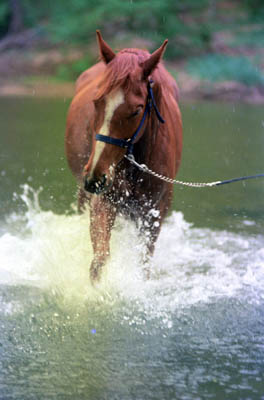
-
Rabicano (Spanish for white tail)
[Equine Coat Color] In a Rabicano there are a few white colored hairs, often on the hindquarters, dock and tail, scattered on a darker colored background. Rabicano is different from a true roan in that a roan has evenly interspersed white hairs throughout the body, except its head and legs. Rabicano coloration can be seen in some Arabians, American Quarter Horses, Thoroughbreds, and various Warmbloods or less known breeds. It appears to be on a generic basis.
-
Rabies
[Veterinary Medicine] Rabies is a vaccine-preventable, zoonotic, viral disease affecting the central nervous system in mammals. It is very rare in equines. There were 13 cases of rabid horses and mules in the United States in 2018, all fatal. Rabies infection usually occurs by the bite of a rabid animal or when fresh saliva from an infected animal contacts a open area or mucous membranes. Symptoms may be head pressing to solid objects, inability to stand, uncoordinated movements, muscle weakness, excessive sensitivity to touch, muscle tremor, lameness, anorexia, loss of tail and anal sphincter tone, loss of sensory perception in the hind limbs, fever, colic, lethargy, convulsions, self-mutilation, and aggressiveness. Many of these symptoms are common in other serious maladies, leading to difficulties in establishing a firm antemortem diagnosis. The true number many be slightly larger than reported. Living in the country, I have observed animals, whose behavior is consistent with rabies. It is a good idea to dispatch them rather than take a chance they might interact with children or other domestic animals, including your horses.
-
Racing
[Equine Sport] See Horse Racing
-
Rack
[Equine Gait] The rack is one of 5 gaits processed by the American Saddle Horse breed. It is a 4-beat gait with each foot hitting the ground separately. The motion is quick and energetic with the head carried high. It is an impressive sight. At horse shows when the rack is called for the audience always becomes very animated. However easy for the rider, the rack is rather hard on the horse and is not a gait for prolonged riding. It is also a gait that is not a natural one, it requires training to develop in a horse but most horses will pick it up without harsh measures.
-
Rain Rot (Dermatophilosis)
[Veterinary Medicine] Rain rot is a condition of the horse's skin caused by the actinomycete Dermatophilus congolensis and manifests during persistent damp weather. It is found on the back and haunches as a bumpy, scabby skin, associated with hair loss. Under usual conditions Dermatophilus congolensis is part of the skin's normal flora and causes no problems. Treatment consists of removing the scabs by bathing the horse with antimicrobial shampoos and attention to currying and brushing.
-
Ratcatcher
[Riding Apparel] A ratcatcher shirt is a high collar shirt that is considered appropriate for informal hunt wear or for ordinary showing. It is generally worn with a stock tie. The origin of the term is uncertain and may be either pejorative or may be descriptive from a time when hunts also chased other local animals considered vermin, such as rats. A ratcatcher coat is a tweed jacket, worn informally during cub hunting (hunt training exercises) and by visitors riding with the hunt.
-
Rate
[Fox Chasing] The term rate is likely a shortened form of "berate." The huntsman or whippers-in reprimand a hound that has misbehaved during the hunt with harsh voice instructions and accompanying cracking of the whip. The point is generally taken, but it is an opportunity for an inexperienced hound to learn.
-
Rearing
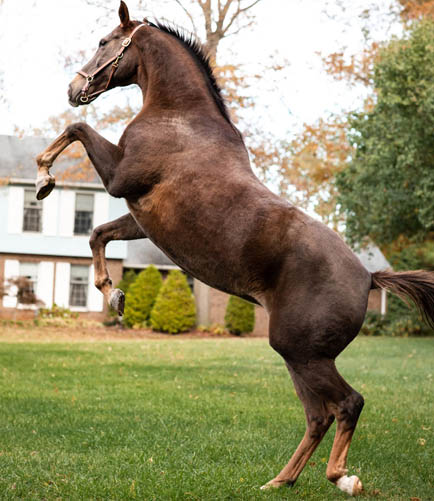
Photo by Bethany Pastorial
[Equine Behavior] A rearing horse stands on its hind legs with the forelegs off the ground. It is a common behavior in wild stallions and uncommon in mares. Domestic horses are fully capable of rearing and can be trained to do so on command. When done spontaneously, it needless to say, is dangerous to the horse's handler. It is indicative of aggression, misbehavior or it some cases pain.
-
Rear Jockey
[Western Saddle Terminology] A rear jockey is a leather piece located at the back of the saddle, following the contour of the horse's body that helps fit the saddle on the horse. It often features decorative stitching or tooling and plays a vital role ensuring the saddle does not shift during movement. A similar construction is not found on many other types of saddles.
-
Recognized Hunt
[Fox Chasing] A recognized fox hunt is one approved by and run according to the rules of the Masters of Foxhounds Association of North America (MFHA). In addition to these, there are informal hunts that function within local communities.
-
Recognized Show
[Horse Showing] A recognized show is one sanctioned by and run according to the rules of a national organization that is considered the governing body of the particular equine sport.
-
Recurrent Iridocyclitis (Moon Blindness or Periodic Ophthalmia)
[Veterinary Medicine] Recurrent iridocyclitis is serious, recurring inflammatory of the eyes that can result in total loss of sight over time. Signs of inflammation appears in either one or both eyes suddenly and then remit in a few days. The horse is sensitive to light, has a closed eye lids, constricted pupils, conjunctivitis and lacrimation. Riboflavin may have preventative value, but is not helpful in treatment. Certain species of bacteria may also play a role and can be treated with antibiotics. Autoimmune etiologies are suspect and can be treated by steroids. I should point out that this condition may represent several different diseases with different causes, all presenting with the identical symptoms of recurrent iridocyclitis. In addition, there are several common and less serious conditions that present with some of the symptoms of recurrent iridocyclitis. There is no substitution for a prompt veterinary consultation if this condition is suspect.
-
Recurrent Seasonal Pruritis (Sweet Itch)
[Veterinary Medicine] Recurrent seasonal pruritis is a chronic allergic reaction to insect bites. The horse scratches itself with its teeth or rubs against solid objects in its environment. There are many causes of itching in horses. A hypersensitivity response to salivary proteins in the Culicoides genera (type off biting midge) is a common cause of a pruritis that disappears in the winter. A full body fly rug and insect repellents are helpful.
-
Red Maple Tree Leaves (Acer rubrum)
[Toxic Plant for Horses] Wilted leaves of the red maple tree are toxic to a horse. They contain gallic acid and it is believe a second yet unidentified toxic agent. These produce a condition in which large quantities of red blood cells are suddenly destroyed (hemolytic anemia). The poisoning is manifest by lethargy, discolored urine from blood breakdown products and dusky gums from a lack of oxygen in the blood. Horses are fairly good about excluding dead leaves when they graze but if there are a large quantity in their environment they may ingest some. It is estimated that they would need to eat over a pound to reach a dangerous dose. The red maple leaf is recognizable as the one in the Canadian flag. If you have some in the area of your pasture you should strongly consider breaking the old chain saw out.
-
Red Ribbon
Red Ribbon
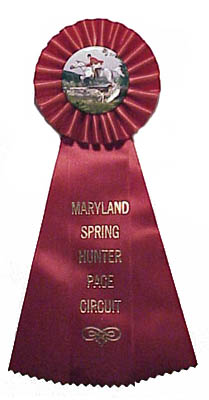
|
[Horse Showing] A red ribbons is given for a second place finish in the United States. In the United Kingdom it signifies a first place finish.
-
Refusal (Bulking)
[Equestrian Jumping] A refusal is when a horse fails to jump a fence as required on the course. A rider will receive penalty points when this occurs. It is also any similar event during more ordinary recreational jumping. The fault may be with the horse, with the human or more commonly both. The advantage or disadvantage of riding a horse is that it has its own brain and will size up a situation. There are those times when a horse uses better judgement than the rider and a refusal saves both from catastrophe.
-
Registration Certificate (Papers)
Registration Certificate
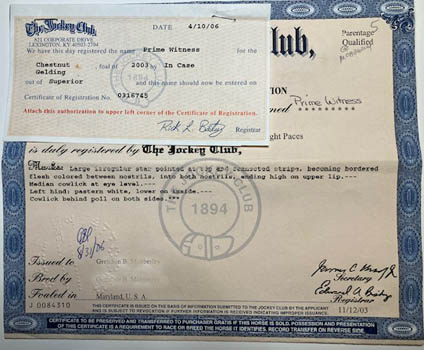
|
[Statement of Breeding] A registration certificate is a document that attests to an individual horses breeding, identity and ownership and that assigns a registration number to the animal.
-
Rein Aids
[Basic Horsemanship] There are five basic recognized rein aids used by riders in controlling horses: direct rein, indirect rein, opening rein, closing rein and pully rein. Horses are not born with a knowledge of these, but must be trained to understand the rider's intention. The most basic of these is the direct rein and the pully rein is only used in emergencies.
-
Rein-Back
[Dressage] Rein-Back is the dressage term for precise backing movements. In a rein-back the horse takes backward steps in diagonal pairs and ends with its feet properly squared. If that sounds as if it should be easy for the horse and rider to master it is not. Basic backing for the novice horse is somewhat counterintuitive. The animal is being asked to step back to a place it cannot see when it feels it is perfectly capable to go forwards and then turn into that place. For the most part backwards pressure on the bit indicates a stop or a slowing to the horse. However, in the case of backing it signals the animal not to go forwards. The rider also remains upright providing another cue to the horse and finally pressure with the legs tells the horse to do something but the other aids cue "not forwards." Once the horse figures this out the prompt release of aids tell the horse it correctly interpreted the riders intention. It takes a fair amount of work on the part of a novice rider and mount to pick this up. In dressage this is refined to the degree that an observer barely perceives the riders use of any aids.
-
Reining
[Equestrian Competition] Reining is a western riding rodeo competition in which the horses are required to execute a prescribed pattern of various reining maneuvers, including circles, pauses, flying lead changes, rundowns, sliding stops, spins and roll backs. These were originally skills needed to manage cattle from horseback.
-
Reinsmanship
[Driving Competition] Reinsmanship is a driving competition in which the driver's skill and the degree of communication between the driver and horse or horses is judged.
-
Release
[Equestrian Jumping] The release in jumping describes the manner in which the rider uses their hands in respect to the contact of the bit on the horses mouth. The two types of releases are the crest release and the automatic release. The objective of a release is not to jerk the horses mouth while jumping, but to carefully follow its motion.
-
Renvers (French turned back)
[Dressage] In renvers a horse is advancing diagonally across the ring on two tracks with the forelegs on the inner and the hind legs on the outer and the body slightly bent.
-
Reserve Champion
[Equine Competition] The reserve champion is the second place winner of the championship category. A combined yellow, red and white ribbon is awarded in the U.S. or blue and white in the U.K. Nearly every nation has its unique color system for ribbons.
-
Rheinlander (Rheinisches Reitpferd-Rhinish Riding Horse)
Rheinlander (Courtesy of Wikipedia and Sara Landvogt
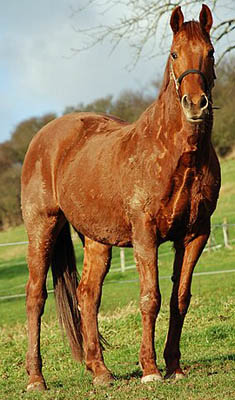
|
[Equine Breed] The Rheinlander is a type of German warmblood sport horse. They are tall, athletic and strong boned.
-
Rhinopneumonitis
[Veterinary Medicine] Rhinopneumonitis is a viral respiratory infection of horses. In some cases serious neurological complications and abortions may be associated with the illness. Its symptoms include nasal discharge, cough, fever and weakness.
-
Ride and Tie
[Equine Competition] Ride and Ties are contests in which a one horse and two person team alternate running and riding in such a way that they leapfrog with one of the people riding and then either tying the horse until the other person can catch up on foot or just handing it over to the next rider rider, while the first person is again running. Distances can vary between twenty and one hundred trail miles. Interestingly, these competitions were started in 1971 by Bud Johns, public relations director for Levi Strauss & Co.
-
Riding Habit
[Equestrian Equipage] A riding habit is the formal attire that is typically worn by a horseback rider often during showing or fox chasing and the term is especially applied to woman's attire. A more casual rider might wear certain elements of it.
-
Riding Helmet
[Equestrian Equipage] Riding helmets are worn for safety while riding or somethings even working around horses. They are designed to provide some protection to the skull and brain but the protection is not absolute. When the helmet hits the ground the brain can "bounce around" within the skull and a person may still have a resulting concussion. Things would have been worse with no helmet. Then a helmet has cracked the ground with some force it is compromised and should be replaced. Attitudes regarding helmets have evolved. When we were younger, we were haphazard in wearing our hunt caps with their elastic chin straps. After more experience we ruled we would never ride without a well-designed safety helmet. As a trail rider, they are also invaluable when you have a close call from a low branch. You will find typical helmets worn by English riders and there are hard hat modifications to cowboy hats to improve their safety, as well.
-
Riding Off (Bump)
[Polo] Riding off is a polo defensive move in which a player maneuvers his pony's shoulder against the other player's pony's shoulder and pushes it so that the ball is out of reach. The player may push as well, but elbows may not be used. It is also called a bump.
-
Riding Pony
[Pony Type] Riding ponies were originally developed in the United Kingdom as crossbred children's show ponies. They are a equine type classification rather than a true breed. Conformed like a small horse rather than a typical pony, they have relatively small heads and ears appropriate to their size. There is some movement toward developing them as a breed, but that has not happened as yet.
-
Ringmaster
[Showing] The ringmaster is a horse show official who works alongside the judge to direct and organize the riders in the show ring.
-
Ringworm (Dermatophytosis)
[Veterinary Medicine] Ringworm is a fungal injection of the hair and hair of horses, caused by Trichophyton equinum and Microsporum canis. It causes round scaly patches on the skin of is treated topically.
-
Riot
[Fox Chasing] A pack of hounds are said to run riot when they become disorganized and run on the scent of some animal other than the fox. This is to be avoided at all costs but happens. I have seen a deer bolt from a woods at full speed and seconds later followed by a couple of hounds in full cry miles from where any hunt was being conducted. I wondered how they were ever going to recover those hounds.
-
Roach Cut
[Horse Grooming] A roach cut describes a mane that has been trimmed short and to the point all the hairs stand up straight.
-
Roadsters
[Horse Category] Horses used for light driving rather than for draft work were referred to as being roadsters.
-
Roan
[Equine Coat Color] A horse is said to be roan if white hairs are mixed with any other solid coat color.
-
Rocky Mountain Horse
[Equine Breed] The Rocky Mountain horse is a gaited breed developed in Kentucky. Most are a dark brown color called with a pale, mane and tail. They have a natural ambling four-beat gait, called the single-foot.
-
Rodeo
[Western Horse Competition] Rodeos are events that feature various forms of western riding, many of them drawn from skills needed in handling cattle and horses. The word is taken from the Spanish rodear, meaning go round, Events include calf roping, bronc riding, bull riding, steer wrestling and barrel racing. There is a lot of action and a degree of danger. Rodeos are more common in the western United States. The National Finals Rodeo (NFR) is the premier championship rodeo of the Professional Rodeo Cowboys Association (PRCA). Perhaps Australia is next to the U.S. in number of rodeos. Since the ranching culture developed in Mexico and spread to the American and Canadian west, it is no surprise that Mexico have similar events called Charreadas.
-
Rollback
[Horse Maneuver] A horse doing a rollback generally executes a fast 180 degree pivot on its hindquarters in a limited area. It is seen in both English riding during show jumping when fences are placed in such a way that the jumper must quickly turn and reorient to a jump placed at an extreme angle to the prior one and also in Western riding during reining demonstrations. In show jumping the rider might be giving an option of doing the rollback or going the long way around and facing a time penalty.
-
Roller Snaffle Bits
[Equine Equipage] Roller snaffle bits have a small rotating medal drum set in the mouth piece that encourages the horse to play with the bit, and causes salivation in the horse, leading to better acceptance of the bit.
-
Rolling
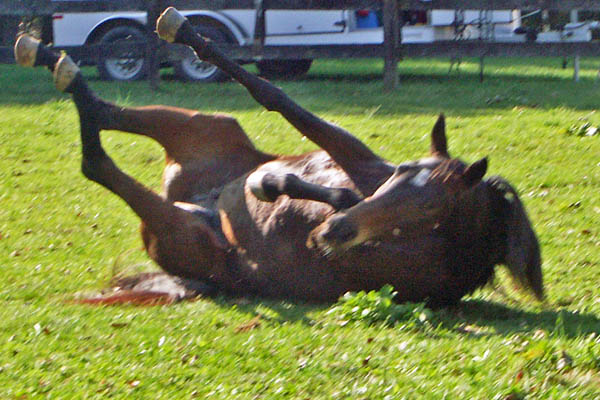
[Horse Behavior] It is natural for horses to roll, but in rare cases it is a response to pain, such as colic or labor. Typically, it begins with a horse looking for a place to roll. Its head is down and it often circles around and paws the ground. If it likes the spot, it drops and rolls over several times, often letting out grunting sounds. The first time I watched this I swore the there was no way the animal could stand up again, but they always do. They tend to let out a grunt and shake all over. The implied reasons that horses roll are many. They may have an itch, a coat that is sheading or in the case of stallions it is felt they use it to mark territory. I am sure if horses spoke they would tell you that it just feels good.
-
Romal Reins
[Equine Equipage] Romal reins on western tack are a closed rein, unlike other western reins that are not joined, but are held together while riding. These closed reins join together after passing the horse's neck and then have a farther section called a romal, which the rider holds in their non-dominate hand. In western riding the rider holds the reins with their elevated non-dominate hand and uses the dominate hand for working functions, such as roping. The horse is taught to neck rein when the rider wishes a turn.
-
Roman Nose
[Equine Appearance Attribute] A horse having a Roman nose shows a convex profile to the nasal dorsum. The opposite profile is called a dished face. A Roman nose is a often, but not always, mark of draft blood in a horse's breeding.
-
Roman Riding
Roman Rider Dusti Dickerson
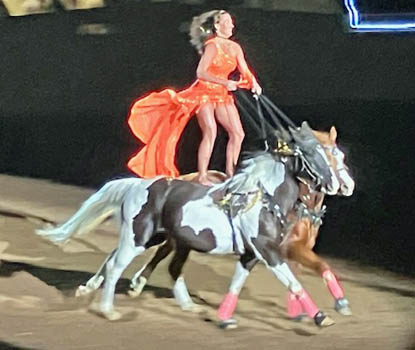
| 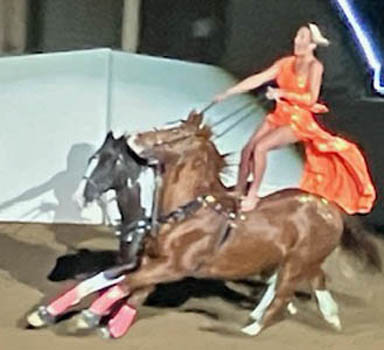
|
[Equestrian Entertainment] Roman riding is a type of trick riding in which the rider balances on a pair of galloping horses. I sometimes go to horse shows, watch competitors and think I could do that (I know I can't). When it comes to Roman and other forms of trick riding, I do not even fantasize that I would do those.
-
Rope Halter
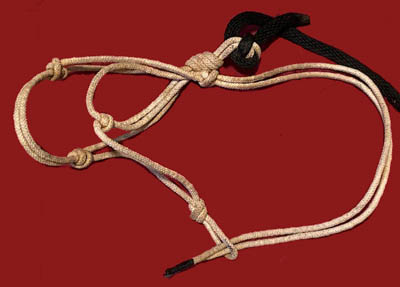
[Horse Equipage] The usual halter is made of flat leather or nylon and buckles or hooks in place. A rope halter is made of rope, commonly 5/16 inches thick, that is folded and knotted into the shape of a halter. This is done in such a way that there are two parallel rope strands behind the pole and over the nose. It is tied off using the loop with a half hitch on the left side of the face so that the end is facing down and away from the eye. The advantage of a rope halter is that it puts a little more pressure on the horse's face at the contact points and is harder for him to ignore. A knowledgeable rider can fashion one on the trail from a length of rope and they hold up very well with rough use.
-
Rose Gray
[Equine Coat Color] A rose gray horse has a mixture of white and chestnut hairs.
-
Rough Board
[Equine Management] Rough board is a boarding arrangement in which the horse may have rights to pastures and a stall, but the horse owner is totally responsible for feeding, care and clean up.
-
Roughshod
[Horse Shoeing] A roughshod horse has shoes with nailheads slightly projecting in order to prevent slipping. This type of shoeing is obsolete and we would now add removalable studs. The problem with roughshod shoes were that the projections might catch on things pulling the shoe off and damaging the hoof. If a horse kicked another, the damage would be considerable and, worse yet, if you were run over by a roughshod horse, you would be much the worse for wear. Hence the term, "to run roughshod over."
-
Round Pen
[Schooling] A round pen is a round enclosure with a gate and high walls and may be constructed of wood or metal. The pens are used for the initial starting of green horses and for training thereafter. A typical round pen is built on level ground and is about 60 feet in diameter. The round shape is desirable because uncooperative horses will often run into corners in square or rectangular enclosures and turn their flanks to the trainer. A round pen should be inmate enough that the horse must interact with the trainer and the trainer can easily follow the horse on foot but large enough to allow the horse to circle in various gaits. However, a pen is just a tool and the critical element is the skill of the trainer using it.
-
Rowel
Spur with Rowel
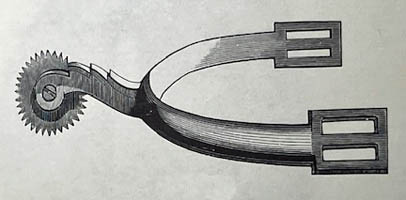
|
[Equine Equipage] A rowel is a small wheel with teeth set on the end of a spur. They are more commonly used by western riders as opposed to those riding English. There was a concern that a rowel might inflict a laceration on the horse's back if a rider slide off to the side during a fall.
-
Royal Andalusian School of Equestrian Art
[Equestrian Institution] Royal Andalusian School of Equestrian Art is a Spanish Institute devoted to the conservation of the Andalusian, training of competitive riders in dressage, and a wide range of other activity in support of its mission. It is similar to the Spanish riding school of Vienna, Austria, which is more familiar to Americans. It is located in Jerez de la Frontera, Spain in Andalusia and does produce shows for visitors.
-
Royal Regiment of Horse Guards (The Blues)
[Military] The Royal Regiment of Horse Guards (The Blues) was a cavalry regiment of the British Army, part of the Household Cavalry. In 1969 it was amalgamated with the Royal Dragoons (1st Dragoons) to form the Blues and Royals. The regiment maintains a mounted troop, which conducts a colorful mounted changing of the guard ceremony in the courtyard in front of the Horse Guards building.(facing Whitehall). This ceremony is less well-know than the foot ceremony at Buckingham Palace but is a must see by any horse lover when visiting London. You are likely to get a front row seat without the mass of usual tourists. The term "horse guards" is also applied to the once traditional home of the British the War Office military headquarters in the Horse Guards building. The Blues and Royals wear a blue tunic, a metal cuirass, and a matching helmet with a red plume.
-
Rubber Snaffle Bit
[Equine Equipage] A rubber snaffle bit covers the steel month piece with a layer of rubber. They come in various snaffle styles. This bit is considered very mild and useful in horses with sensitive mouths or for young horses learning to accept a bit.
Rug (British Usage)
[Equine Equipage] A rug is a term for a horse blanket..
Run In Shed
[Equine Management] A run in shed is a small building set up in a pasture in which horses can seek shelter from the elements or shade. It is particularly necessary if they do not have free access to their stall in the main stable.
-
Running Martingale
Running Martingale
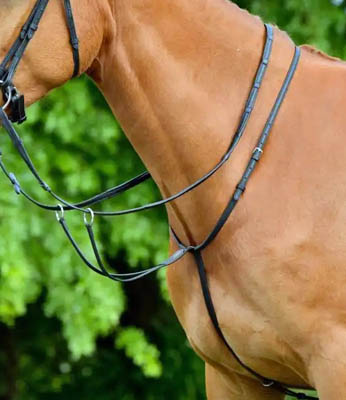
|
[Equine Equipage] A running martingale is an optional piece of tack designed to keep a horse from throwing its head upwards. On one end it attaches to the grith, runs between the legs, divides into two pieces, forming a Y shape and passes upwards to be suspended by attached rings from each of the reins. Supplemental neck straps pass upwards and hold the martingale flush to the horse's chest. If the horse throws its head upwards pressure is then transmitted to the bit, causing the horse to stop. Running martingales are the only style of martingale permitted for use in eventing competitions and horse racing.
-
Running Walk
[Equine Gaits] A running walk is a natural gait seen in certain gaited breeds, for example Tennessee Walkers. It is a steady half-walk, half trot that can reach speeds of 6 to 8 miles per hour.
-
Run Out
[Jumping] A run out is when a horse dodges past (generally at the last possible moment) one side of a standing jump rather than jumping the fence as required on the course. A rider will receive penalty points when this occurs but it is a rare occurrence among veteran riders and mounts. It is also any similar event during more ordinary recreational jumping. I rode a mare who I could count on the pull this stunt and it took much ring work on my part and hers to properly correct the problem. In all honesty, I feel the fault was with both of us and I realized that every time she successfully did it we were reinforcing the bad behavior. Properly jumping with a horse requires a complex series of timed and coordinated steps on the part of the rider and a willingness on the part of the animal. It is not so easy to master.
Glossary of Equestrian Terms: Main Alphabetical Listing
Links to Other Sites with Equestrian Interests
Back to Introduction











